May 30, 2025 | 10:03 GMT +7
May 30, 2025 | 10:03 GMT +7
Hotline: 0913.378.918
May 30, 2025 | 10:03 GMT +7
Hotline: 0913.378.918
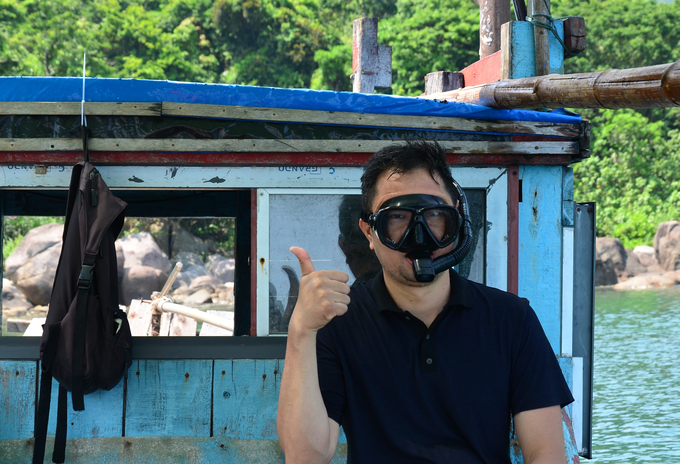
VAN's reporter is practicing breathing with a snorkel on the ship. Photo: Cong Dien.
To dive, people must undergo a week of training and be granted an "Open" certificate capable of diving to a depth of 18m. Wanting to dive deeper must have an "Advanced" certificate.
Those who are just starting to practice will first have to practice face down in the water to breathe with a snorkel tube and a pair of glasses with a nosepiece. All day long, face down in the water. Exposing your back to the sky under the sun of 39-40 degrees Celsius is not an easy challenge. There is also a feeling of numbness in the whole body in the evening and the risk of skin peeling.
However, that is nothing compared to actual diving. Scientists must bring complete equipment, including prosthetic legs, diving suits, oxygen tanks, and lead wires. If you accidentally make a mistake, you can stay on the seabed forever due to wearing more than 10 kg of lead and a diving suit with many buckles.
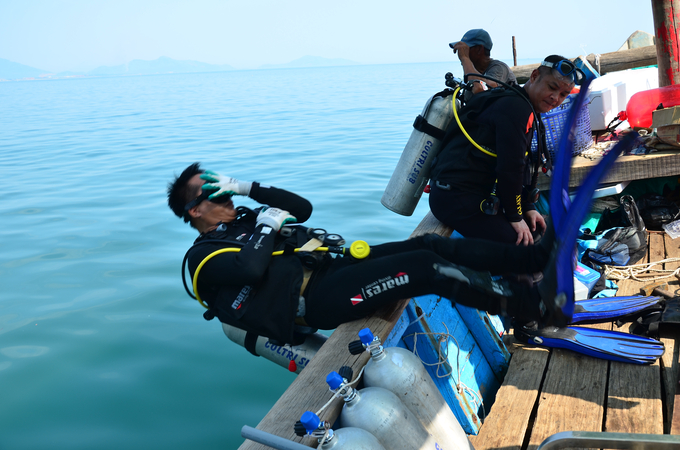
The water touch posture of the divers. Photo: Duong Dinh Tuong.
Breathing with an oxygen hose when diving deep into the sea floor is different from holding a tube during exercise because the force is much heavier, and the body has to overcome the instinct of fear.
Underwater diving has many fears: Fear of being alone. Fear of the dark. Fear of strange shapes. Fear of strange noises. Fear of equipment malfunction. Fear of obstacles. Fear of being swept away. Fear of temperature difference between underground flows. Fear of sharks, etc.
Usually, the underwater image will be magnified nearly twice, so the fish with the thigh size looks as big as a communal pillar. The deeper you dive, the more pressure increases, causing ear pain. To pass, the diver must reduce the pressure by covering his nose and breathing hard to let the air out of his ears.
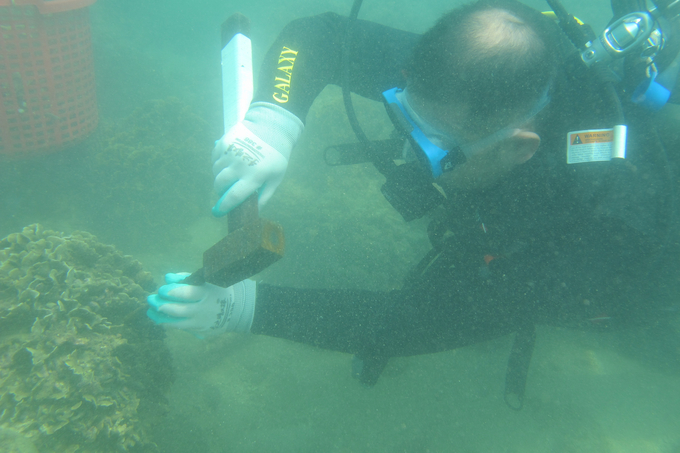
Officers of the Research Institute for Marine Fisheries are separating seed corals. Photo: Cong Dien.
In the sea, divers also need to keep a balance like a fish, breathe just enough to avoid oxygen loss, can work longer in the movements of bending down to grow coral.
It takes a lot of work, but what you get when you get to the bottom of the sea is worth it. The sun shines down, and the sunny flowers shimmer on the seabed. A few clusters of bright flowers are like spotlights, rotating in all shapes and sizes, looking very interesting. The rays of sunlight are filtered through the azure water like silk from the sea, smooth and strangely shiny. Thousands and tens of thousands of air bubbles that catch the sun are also glittering and shining like pearls. Everything is as magical as the world of the king of water.
That was the initial feeling. When I calmed down, I saw that the bottom of Ca beach, in the Hai Van - Son Cha area of Thua Thien - Hue province, was empty of fish. Only finger-sized fish are clinging to the coral with their mouths to find food. From time to time, a fish the size of three fingers appears.
Scientists from the Research Institute for Marine Fisheries dived and cultured coral in Lang Co, Hue. Clip: The Research Institute for Marine Fisheries.
The scene is more tragic when diving deep. The seabed is almost empty, rough, and rocky, showing no sign of life. The corals are absent, and the fish are not found.
Master Nguyen Van Hieu confided that since 2005, the marine resources have decreased. Co To Island (Quang Ninh province) in 2006 had a mass coral death. This area used to be over 300 hectares wide, with all colors of blue, red, purple, and yellow, but when it died, the coral turned white, then turned black-brown as it burned.
About seven years ago, scientists who went to Co To scuba diving were also shown where to see the last coral tree. It was as big as a bed with an ivory-white color, but then it was collapsed by a fisherman who caught fish in mines, dying to rock.

Officers of the Research Institute for Marine Fisheries are diving. Photo: Cong Dien.
The fish also moved without corals because there was no place to hide or food source. Pollution from coal mining, mining, and many other harmful chemicals and how people exploit mollusks with high-pressure suction pumps, plowing the bottom layer causes a dense layer of dust and organic matter on the seabed, killing all living things.
If a big storm on land rages for a week at most, then a "storm" under the sea rages all year round. It makes the coral reefs in Co To almost die. Twenty years later, it has not been able to recover.
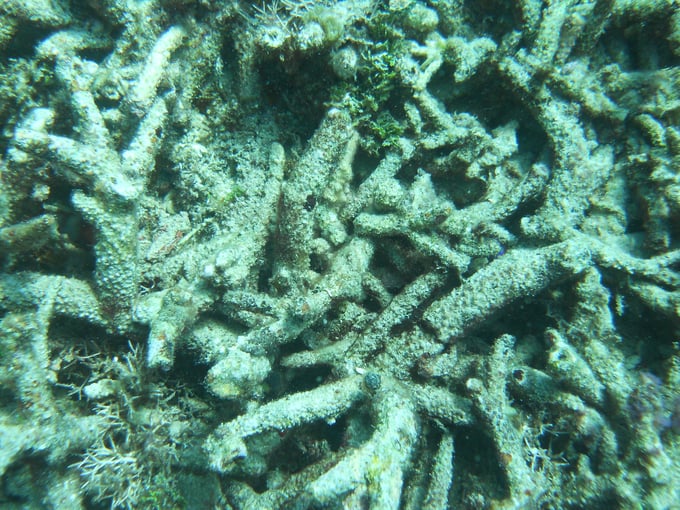
The close view of dead coral reef. Photo: The Research Institute for Marine Fisheries.
In 2010, coral bleaching occurred on Nam Yet island outside the Truong Sa archipelago due to El Nino increasing sea temperature. Just one °C above average, the coral polyp layer will push the algae living in the tissue out of the body, ending the symbiotic relationship. An estimated 90% of Nam Yet Island's corals were dead then.
Research by masters Nguyen Van Hieu and Do Van Khuong in 2013 recorded four areas with coral reefs in severe degradation, namely Co To, Nam Yet, Ly Son, and Cat Ba. In contrast, coral reef degradation in Marine Protected Areas ('MPAs') was milder, about 14.5%, compared with 34% in non-MPAs.
Coral reef degradation due to natural factors is an issue that should consider by MPAs in their plans and strategies to adapt and minimize negative impacts on marine biodiversity.
Translated by Ha Phuc

(VAN) Ms. Nguyen Thi Dung, Deputy Director of Ngoc Hoang Cooperative, shared about the journey of bringing dragon fruit to Europe, achieving annual revenues in the billions of VND.

(VAN) Bamboo products from Thang Tho Bamboo Cooperative have reached many countries around the world, while also creating jobs for local workers.

(VAN) The Management Board of Con Dao National Park reported that a green sea turtle, tagged in the Philippines, has traveled thousands of kilometers to lay 84 eggs on Bay Canh Islet.
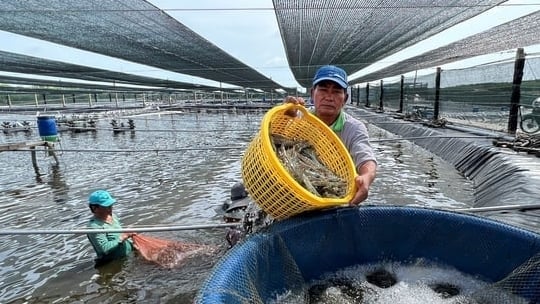
(VAN) Green technology is paving a new path for sustainable aquaculture in the Mekong Delta in particular and across the country in general, helping reduce emissions and adapt to climate change.
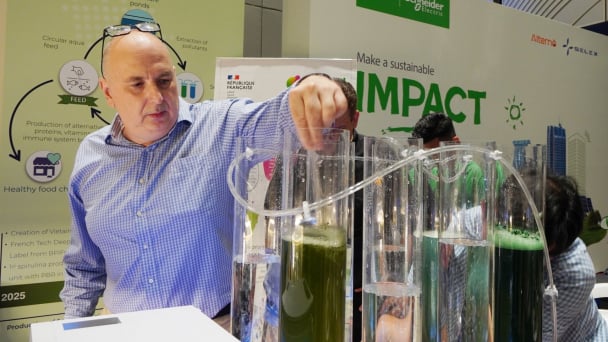
(VAN) On May 27, La French Tech Vietnam (the French startup and innovation community in Vietnam) held the French Tech Summit Vietnam 2025.
/2025/05/27/4731-2-223159_980.jpg)
(VAN) No votive paper, no styrofoam, no plastic bags, no plastic bottles, and no single-use plastic trays are the key rules tourists should keep in mind when visiting Con Dao.
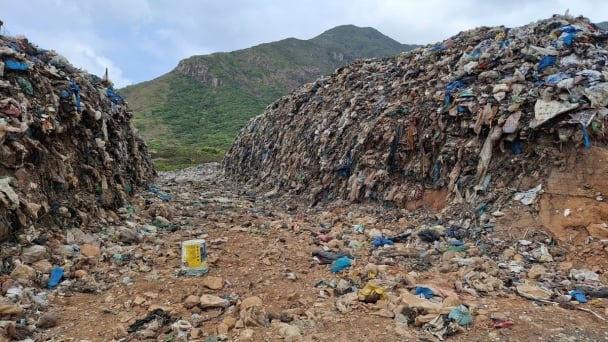
(VAN) In the fight against plastic pollution, Vietnam has been demonstrating a proactive, pioneering, and active role in addressing the greatest environmental challenge today.